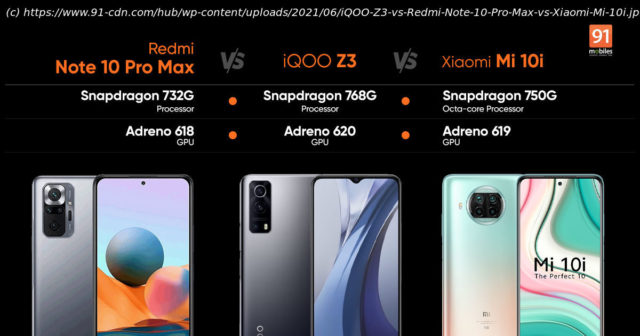iQOO Z3 goes against the Redmi Note 10 Pro Max and the Xiaomi Mi 10i. The three noteworthy contenders have been compared based on benchmarks and gaming
Off-late, there has been a barrage of enticing affordable phones in the market, each touting excellent cameras, high refresh rate displays, and stylish designs. That said, the area which has seen the most improvement in recent times is undoubtedly the performance of mid-range phones, which can be accredited to brand-new SoCs from the likes of Qualcomm and MediaTek. Case in point, the newly-launched iQOO Z3 that ships with Qualcomm’s 5G enabled Snapdragon 768 processor. Of course, the question on everyone’s mind is – just how good is the new Snapdragon 768 chipset and does it warrant a purchase over devices like the Redmi Note 10 Pro Max ( review) and the Xiaomi Mi 10i ( review) that feature Qualcomm’s Snapdragon 732G and 750G SoCs respectively? Well, if you are finding yourself in a similar rut then fret not as in this article, we will be putting all your doubts to rest. Read on to know which of the three SoCs offer the best performance for your buck. Benchmarks rarely tell the whole story, but they do help users ascertain or at least get an idea of a smartphone’s computing prowess. To that note, let’s kick off this performance comparison by running a slew of synthetic tests, including Antutu v9, GeekBench v5, and GFXBench. Starting with the Antutu benchmark, we deployed the latest version of the synthetic test (v9) on all three phones which offers more GPU tests compared to the previous iteration of the software. The utility also factors in a phone’s storage and RAM, alongside its 2D and 3D graphics performance before outputting a score, and consequently, is a solid tool to get a gauge on a phone’s overall computing prowess. Unsurprisingly, the Snapdragon 768-toting iQOO Z3 absolutely obliterated the competition and outputted a score of 4,52,594 points in the first run. In comparison, the Xiaomi Mi 10i with its Snapdragon 750G scored 3,78,559 points, while the Redmi Note 10 Pro Max found itself at the tail end of this comparison with a score of 3,26,764 points. To tax the smartphones a tad more, we ran the Antutu benchmark two more times on the aforementioned devices. Here, the iQOO Z3 dipped its score by around 1,000 points in the second run and outputted a total score of 4,51,614 points. The Xiaomi Mi 10i, on the other hand, saw an increase of around 1,000 points in its score and produced 3,79,946 points in the second run. The Redmi Note 10 Pro Max was the worst offender of the lot and saw its score dip to 2,99,434 points in the second run, which amounts to a difference of over 26,000 points. In the final run, iQOO Z3 witnessed yet another dip of around 1,000 points in its overall score and outputted 4,50,467 points in the third run. The Mi 10i, yet again, showed an improvement of over 1,000 points and produced a score amounting to 3,81,279 in the third run. The Redmi Note 10 Pro Max saw yet another dip in its score, which reduced further to 2,97,530 points. Clearly, both the iQOO Z3 as well as the Xiaomi Mi 10i operate admirably under sustained loads, but the Redmi Note 10 Pro Max’ performance throttled quite a bit.






